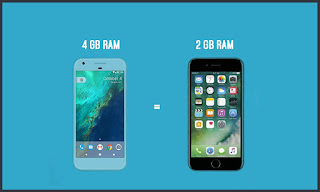Why does the iPhone require less RAM than Android devices?

There are people who always fight when it comes to comparing the Android devices vs iPhone. Iphones are way more expensive than Android devices even with the same specifications. However, the iPhone works a lot smoother and faster than an Android device with the same amount of RAM. That means an iPhone with 2GB RAM works much faster than an Android device with 2GB RAM with same features. If you compare the performance of iPhone 7 (2GB RAM) with Google Pixel (4GB RAM) or Samsung s7 (4GB RAM), You’ll see no difference in performance. iPhone 6 was the best performing phone in its time with just 1 GB of RAM. Now, the question is why does the iPhone require less RAM than Android devices? Why does the Android device need more RAM? Why does the iPhone require less RAM than Android devices?